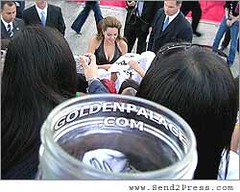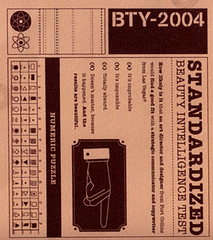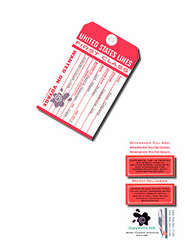When I returned from Long Beach (where I was covering one of three industry roundtables responsible for guiding the development of the nation's next generation 911 system), I was greeted by two requests soliciting our services to assist with 'publicity' generation.
It seemed to me they really meant they needed public relations support or perhaps strategic communication planning. What's the difference? Everything. Sure, publicity works for some people and places of business, but it's not for everyone.
For our two prospective clients, I provided a textbook difference between publicity and public relations. For the purposes of this post, I thought it would be more fun to provide an example: Goldenpalace.com recently paid $529.99 on eBay for a ''Celebrity Jar'' that contains the air of Brad Pitt and Angelina Jolie.
The jar, in case you missed it, is an ordinary wide mouth, quart-sized mason jar that the seller brought to the premiere of Mr. & Mrs. Smith in Westwood, Calif. As megastars Pitt and Jolie strolled across the red carpet, the jar was opened to capture the air molecules expelled by the stars of the blockbuster movie. It was then sealed and placed in a safe deposit box.
The Celebrity Jar has been featured on several media outlets, including Access Hollywood, Star Magazine, E! Online, MSNBC, ESPN, and CBS. The extensive media coverage sparked the attention of GoldenPalace.com, the Internet casino that turned the world's biggest auction site into the world's most unlikely publicity vehicle.
''This is another perfect example of pop culture phenomenon,'' said GoldenPalace.com CEO Richard Rowe. ''There is literally nothing in this jar except air, and it has made headlines all over the country and even overseas. The sheer weirdness and absurdity of this item has made it a marketing success.''
In the last year or so, GoldenPalace.com has purchased several pop culture oddities, including the Virgin Mary grilled cheese sandwich, Britney Spears' pregnancy test, Marilyn Monroe's personal address book, and Pope Benedict XVI's previously-owned VW Golf. All of the purchases have garnered extensive worldwide media attention.
Perfect. The odd ball purchases generate publicity while the quote from Rowe is an attempt to infuse some public relations. In other words, Rowe says we buy this stuff because we're interested in exposure and not simply because we're weird or easily duped.
Of course, that is not to say this would work for everyone. Imagine what might happen if your local utility made the same purchase on the same day you received your monthly statement. Right. Publicity works best for flamboyant products and personalities. For the rest of us, public relations remains the better bet unless you're willing to risk a wardrobe malfunction.
It seemed to me they really meant they needed public relations support or perhaps strategic communication planning. What's the difference? Everything. Sure, publicity works for some people and places of business, but it's not for everyone.
For our two prospective clients, I provided a textbook difference between publicity and public relations. For the purposes of this post, I thought it would be more fun to provide an example: Goldenpalace.com recently paid $529.99 on eBay for a ''Celebrity Jar'' that contains the air of Brad Pitt and Angelina Jolie.
The jar, in case you missed it, is an ordinary wide mouth, quart-sized mason jar that the seller brought to the premiere of Mr. & Mrs. Smith in Westwood, Calif. As megastars Pitt and Jolie strolled across the red carpet, the jar was opened to capture the air molecules expelled by the stars of the blockbuster movie. It was then sealed and placed in a safe deposit box.
The Celebrity Jar has been featured on several media outlets, including Access Hollywood, Star Magazine, E! Online, MSNBC, ESPN, and CBS. The extensive media coverage sparked the attention of GoldenPalace.com, the Internet casino that turned the world's biggest auction site into the world's most unlikely publicity vehicle.
''This is another perfect example of pop culture phenomenon,'' said GoldenPalace.com CEO Richard Rowe. ''There is literally nothing in this jar except air, and it has made headlines all over the country and even overseas. The sheer weirdness and absurdity of this item has made it a marketing success.''
In the last year or so, GoldenPalace.com has purchased several pop culture oddities, including the Virgin Mary grilled cheese sandwich, Britney Spears' pregnancy test, Marilyn Monroe's personal address book, and Pope Benedict XVI's previously-owned VW Golf. All of the purchases have garnered extensive worldwide media attention.
Perfect. The odd ball purchases generate publicity while the quote from Rowe is an attempt to infuse some public relations. In other words, Rowe says we buy this stuff because we're interested in exposure and not simply because we're weird or easily duped.
Of course, that is not to say this would work for everyone. Imagine what might happen if your local utility made the same purchase on the same day you received your monthly statement. Right. Publicity works best for flamboyant products and personalities. For the rest of us, public relations remains the better bet unless you're willing to risk a wardrobe malfunction.


















